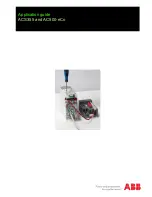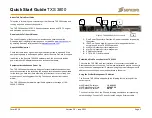
Instruction Manual
D103292X012
C1 Controllers and Transmitters
March 2017
22
c. Unclip the lock spring (key 72). Remove the indicator scale (key 69) and proportional band adjustment knob
(key 73).
d. Remove the gain adjustment bar (key 63). Flip it over so it attaches to the opposite side of the cantilever spring
(key 8) as shown in figure 16 and screw it back down.
e. Flip over the indicator scale (key 69); install it and the proportional band adjustment knob (key 73) as a unit. Snap
in the lock spring (key 72).
f. Tighten down the spring adjustor (key 65) with the bias spring (key 70) and washers (key 62) until it stops against
the gain adjustment bar (key 63).
g. Turn the proportional band adjustment knob to the 10 setting. If it cannot be turned to the 10 setting, loosen the
spring adjustor (key 65).
3. Calibrate using the calibration procedure for proportional-only controllers found on page 12 of this manual.
4. When calibration is complete, return the tubing (key 25) and the proportional band assembly to their original
locations and continue on with step 5 of this procedure.
Note
After reinstalling the tubing (key 25) and proportional band assembly a slight offset of the output pressure will be noticed due to a
combination of switching from the proportional bellows to the reset bellows and the repositioning of the cantilever spring.
Performing step 6b below adjusts for this offset.
For example, assume that a 0 to 100 psig sensing element is being used and the controller is to switch from zero to full
supply pressure at a process pressure of 80 psig with rising process pressure and from full supply pressure to zero at 20
psig with falling pressure. (This is for a direct-acting controller.) The differential gap is:
5.5bar
*
1.3bar
6.9bar
100%
+
60%
80psig
*
20psig
100psig
100%
+
60%
(
)
From figure 10, the proportional band dial setting should be approximately 4.5; rotate the proportional band
adjustment knob to 4.5.
6. Setting the process pressure
For a Direct-Acting Controller:
a. Rotate the pressure setting knob to the pressure at which the controller output is to switch to the upper
switching point (zero to full supply pressure) with rising process pressure. In the above example, this pressure is
5.5 bar (80 psig).
b. Increase pressure to the sensing element while monitoring the output pressure gauge. The controller output
pressure should switch from zero to full supply pressure when the upper switching point is reached with rising
input pressure.
Note
If the upper switching point is not correct, adjust the nozzle to correct the error. Repeat step 6b until the input pressure and upper
switching point are at the desired setting.
















































